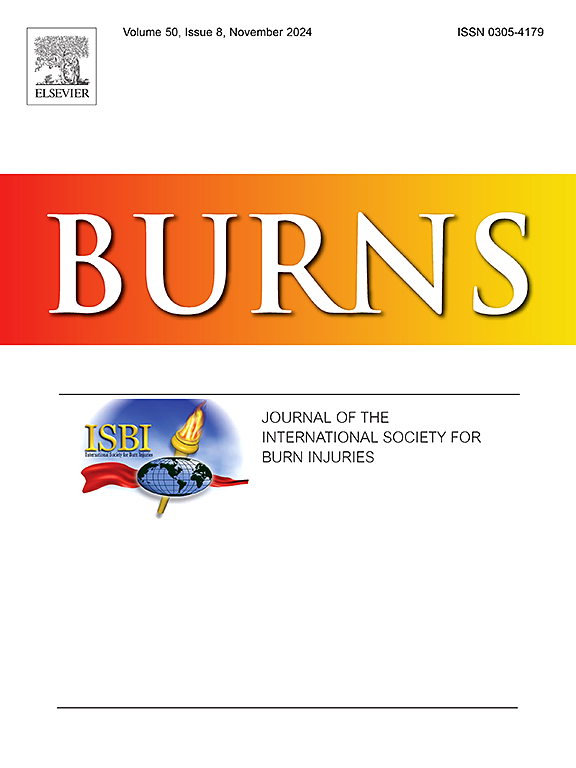烧伤后慢性瘙痒症患者静息态大脑功能活动的改变。
IF 3.2
3区 医学
Q2 CRITICAL CARE MEDICINE
引用次数: 0
摘要
背景:瘙痒是烧伤创面的常见症状,由皮肤组织损伤和组织异常愈合引起。烧伤后慢性瘙痒症(CPBP)是指持续六周或更长时间的瘙痒。烧伤后慢性瘙痒症的大脑机制尚未得到充分了解。本研究旨在探讨 CPBP 患者的脑功能异常,并确定瘙痒症的潜在发病机制:20 名 CPBP 患者和 20 名健康对照组(HCs)参加了研究,并接受了静息态功能磁共振成像(fMRI)扫描。采用区域同质性(ReHo)、低频波动振幅(ALFF)和分数ALFF(fALFF)测量方法对大脑活动进行评估。fMRI 数据的预处理包括切片定时校正、运动校正和干扰回归等步骤,以考虑生理噪音和头部运动。统计分析包括双样本 t 检验,以比较 CPBP 患者和 HC 之间的 ReHo、ALFF 和 fALFF 值,并将年龄作为协变量;斯皮尔曼相关分析,以探讨脑活动测量与临床特征之间的关系:研究发现,CPBP 患者和 HCs 的大脑活动存在明显差异。CPBP 患者在双侧额叶中回、内侧额叶上回、楔前回、左侧岛叶、右侧尾状核和双侧小脑扁桃体等区域表现出较高的 ReHo,而右侧中央前回的 ReHo 有所降低。ALFF分析显示,双侧额叶中回、额叶内上回、右侧楔前回和右侧额叶下回的活动增加,而左侧中央前回和右侧中央后回的ALFF降低。ReHo、ALFF和fALFF存在显著差异的几个脑区与烧伤面积和瘙痒量表评分广泛相关:我们的数据表明,CPBP 患者的 ReHo、ALFF 和 fALFF 值主要在与默认模式网络和感觉运动区相关的脑区发生改变。这些结果可为研究 CPBP 的神经病理学提供有价值的见解。本文章由计算机程序翻译,如有差异,请以英文原文为准。
Altered resting-state functional brain activity in patients with chronic post-burn pruritus
Background
Pruritus, a common symptom of burn wounds, arises from skin tissue damage and abnormal tissue healing. Chronic post-burn pruritus (CPBP) is defined as itching that persists for six weeks or more. The brain mechanisms underlying CPBP are not understood adequately. This study aims to explore abnormal brain function in CPBP patients and identify potential pathogenesis of pruritus.
Materials and methods
Twenty patients with CPBP and twenty healthy controls (HCs) participated in the study and underwent resting-state functional magnetic resonance imaging (fMRI) scans. Brain activity was evaluated using regional homogeneity (ReHo), amplitude of low-frequency fluctuations (ALFF), and fractional ALFF (fALFF) measures. Preprocessing of fMRI data involved steps such as slice timing correction, motion correction, and nuisance regression to account for physiological noise and head motion. Statistical analyses included two-sample t-tests to compare ReHo, ALFF, and fALFF values between CPBP patients and HCs, with age as a covariate, and Spearman correlation analysis to explore relationships between brain activity measures and clinical characteristics.
Results
The study revealed significant differences in brain activity between CPBP patients and HCs. CPBP patients exhibited altered higher ReHo in regions including the bilateral middle frontal gyrus, medial superior frontal gyrus, precuneus, left insula, right caudate, and bilateral cerebellar tonsils, with decreased ReHo in the right precentral gyrus. ALFF analysis showed increased activity in the bilateral middle frontal gyrus, medial superior frontal gyrus, right precuneus, and right inferior frontal gyrus, and decreased ALFF in the left precentral gyrus and right postcentral gyrus. fALFF values were notably higher in the bilateral medial superior frontal gyrus and precuneus. Several brain regions with significant differences in ReHo, ALFF, and fALFF were extensively correlated with the burned area and pruritus scale scores.
Conclusion
Our data suggest that patients with CPBP show alterations in ReHo, ALFF, and fALFF values primarily in brain regions associated with the default mode network and sensorimotor areas. These results may provide valuable insights relevant to the neuropathology of CPBP.
求助全文
通过发布文献求助,成功后即可免费获取论文全文。
去求助
来源期刊

Burns
医学-皮肤病学
CiteScore
4.50
自引率
18.50%
发文量
304
审稿时长
72 days
期刊介绍:
Burns aims to foster the exchange of information among all engaged in preventing and treating the effects of burns. The journal focuses on clinical, scientific and social aspects of these injuries and covers the prevention of the injury, the epidemiology of such injuries and all aspects of treatment including development of new techniques and technologies and verification of existing ones. Regular features include clinical and scientific papers, state of the art reviews and descriptions of burn-care in practice.
Topics covered by Burns include: the effects of smoke on man and animals, their tissues and cells; the responses to and treatment of patients and animals with chemical injuries to the skin; the biological and clinical effects of cold injuries; surgical techniques which are, or may be relevant to the treatment of burned patients during the acute or reconstructive phase following injury; well controlled laboratory studies of the effectiveness of anti-microbial agents on infection and new materials on scarring and healing; inflammatory responses to injury, effectiveness of related agents and other compounds used to modify the physiological and cellular responses to the injury; experimental studies of burns and the outcome of burn wound healing; regenerative medicine concerning the skin.
 求助内容:
求助内容: 应助结果提醒方式:
应助结果提醒方式:


